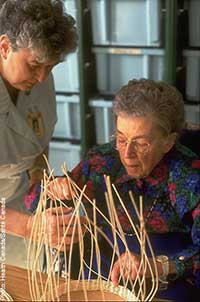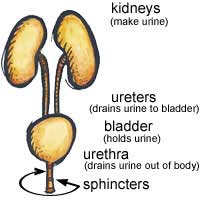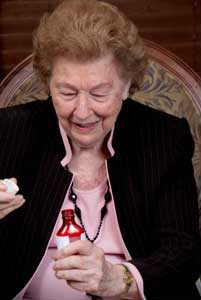
- Urinary incontinence and bladder problems are common in older adults.
- Problems may include going too often to the toilet, having to rush to make it on time, having problems with bladder emptying, or dribbling excessively after bladder emptying and bladder leakage.
- There are several types of incontinence: urgency, stress, mixed, overflow and functional. Some peoplehave more than one type.
- During your consultation, your health care provider will ask you questions to determine the underlying cause of your bladder problem, conduct a physical examination and possibly order some tests, and then discuss strategies for management.
- Management may involve behavioural and lifestyle changes (such as toileting strategies or fluid management), medications, continence products or appliances (such as urinals or collection devices), help with bladder emptying or surgery
- Incontinence can usually be successfully managed and improved.

- Urinary incontinence – the involuntary loss of urine – is a common problem amongst older adults.
- One in three women and one in six men over the age of 65, living in the community suffer from this problem. The problem is very common in older people living in nursing homes, and is very common in people living with dementia.
- Many people are embarrassed to talk about bladder control problems and don’t seek help because they think this is a normal part of aging, they accept the problem or think that nothing can be done. Incontinence is not a normal part of aging and urinary incontinence can be assessed and, for most people, bladder problems can be managed successfully
 How Urine is Made
How Urine is Made
- The body absorbs liquids you drink into the bloodstream through the gut. The kidneys filter the blood and get rid of waste products in the form of urine.
- The urine flows from the kidneys through tubes called ureters, and is stored in the bladder which is made of muscle called the detrusor.
- When you are ready to pass urine, there is a valve (sphincter) at the bottom of the bladder which relaxes and allows the urine to pass down a tube called the urethra so it can be expelled from the body.
Types of Incontinence
1. Urgency. Older people with urgency incontinence may:
- only experience a severe urgent need to pass urine leak without incontinence which can interfere with daily life
- leak urine when they cannot get to the bathroom quickly enough
- urinate very often, both day and night
2. Stress: This is a loss of urine with physical exertion. People with stress incontinence may leak urine when they sneeze, cough, laugh, or exercise. Leakage usually happens in small amounts.
3. Mixed symptoms: This is a combination of stress incontinence and urgency incontinence and is the most common type in mid life and beyond
4. Overflow Incontinence: People with overflow incontinence have a very full bladder of which they may be unaware and they may:
- lose small amounts of urine day or night
- sometimes feel they have to empty the bladder, but cannot
- pass only small amounts of urine despite straining
5. Functional incontinence: This describes a type of incontinence which results from other diseases which prevent a person from being able to reach the toilet successfully or manage their clothing in time to toilet.
Other Causes of Urinary Incontinence
 Incontinence may be temporarily caused by:
Incontinence may be temporarily caused by:
- urinary tract and vaginal infections
- some medications
- constipation
- high blood glucose (sugar) levels
- stones in the bladder
- bladder tumour
- depression
- a poor living environment
Management of Urinary Incontinence
- The first thing to do is to tell your health care provider (e.g. physician, public health nurse, homecare nurse) about the problem.
- Next, your health care provider needs to find out the cause of the incontinence. This usually requires asking you questions. Even though you may be embarrassed to speak about your bladder problem, your clinician is used to these kind of problems and will treat you sensitively. Make sure the physician or nurse knows of all of your medications, including those you might buy over the counter (without a prescription). A vaginal or a rectal examination may be part of the physical examination. Also, certain tests may be done (e.g., blood and urine tests, bladder scans).
- The next step is to treat the cause of the incontinence. The different ways of treating incontinence and bladder control problems are below.
Treatment of Urinary Incontinence
1. Behavioural and lifestyle changes - people can often attempt these techniques themselves:
- Drink around 6 cups of liquids daily.
- Avoid alcohol before bedtime.
- Reduce the amount of caffeine your food and drink
- Try to maintain a normal weight
- Exercise regularly
- If you have urgency incontinence, try to hold on a little before you go to the washroom. As you get better at holding, you can increase the hold time to reduce the frequency of bladder emptying. This is called bladder retraining.
- Decrease intake of liquids after supper if you are getting up a lot at might
- Exercise pelvic floor muscles regularly by squeezing them (ask your health care provider for advice and teaching). These exercises are useful for both stress and urgency incontinence.
2. Medications – the most common types of medicine are those to:
- Treat infection.
- Replace hormones.
- Allow control of urgency.
- Tighten the sphincter muscle.
3. Pessaries
- For women, support the bladder and sphincter in stress incontinence and prolapse (an abnormal bulging of the vaginal walls).
4. Surgery is sometimes needed to help treat certain causes of incontinence:
- Removal of tissue that is causing a blockage (e.g. prostate in men).
- Support the bladder and sphincter in stress incontinence and prolapse.
- Injections into the bladder to prevent urgency and urgency incontinence
5. Continence products: Many types of incontinence products are available. These include different types of pads, special underwear, male and female urinals, and different types of catheters.
For people with bladder emptying problems, sometimes your health care provider will recommend that you pass a tube (catheter) into your bladder several times a day. This can easily be taught or done for you – it is not as bad as it sounds; this is called intermittent catheterisation.
Health Canada
- Seniors and Aging - Bladder Control Problems (Incontinence) provides lots of information about the topic.
The Canadian Continence Foundation
- This organization is for people experiencing incontinence by helping, them and/or their caregivers, to confidently seek and access cures and treatment options.
The Bladder and Bowel Foundation (UK)
- This voluntary organisation in the UK provides help and support for people with bladder and bowel problems
International Continence Society Continence Product Advisor
- This international society hosts a product finder on the public section of its website which can guide you as to the best products to use too help control your problem
The Simon Foundation (US)
- This not for profit organization provides advice and support for people with continence problems